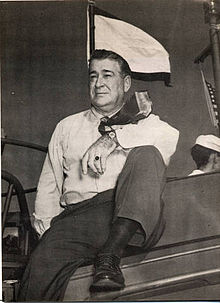Andrew Higgins

Andrew Jackson Higgins (28 August 1886 – 1 August 1952) was the founder and owner of Higgins Industries, the New Orleans-based manufacturer of "Higgins boats" (LCVPs) during World War II. General Dwight Eisenhower is quoted as saying, "Andrew Higgins ... is the man who won the war for us. ... If Higgins had not designed and built those LCVPs, we never could have landed over an open beach. The whole strategy of the war would have been different." Even Hitler recognized his heroic war efforts in ship production and bitterly called him the "New Noah."[1]
Early life and barge/boatbuilding
Higgins was born on 28 August 1886 in Columbus, Nebraska. Higgins completed three years of school at Creighton Prep High School in Omaha, Nebraska before being tossed out for brawling.[2] He left his native town in 1906 to enter the lumber business in Mobile, Alabama. Four years later, Higgins became manager of a German-owned lumber-importing firm in New Orleans. In 1922, he formed his own company, the Higgins Lumber and Export Co., importing hardwood from the Philippines, Central America, and Africa and exporting bald cypress and pine. In pursuing these ends he acquired a fleet of sailing ships—said to have been the largest under American registry at that time. To service this fleet, he established his own shipyard which built and repaired his cargomen as well as the tugs and barges needed to support them.
In 1926, four years after founding the Higgins Lumber and Export Co., the industrialist and shipbuilder designed the Eureka boat, a shallow-draft craft for use by oil drillers and trappers in operations along the Gulf coast and in lower Mississippi River. With a propeller recessed into a semi-tunnel in the hull, the boat could be operated in shallow waters where flotsam and submerged obstacles would render more usual types of propellers almost useless. Higgins also designed a "spoonbill" bow for his craft, allowing it to be run up onto riverbanks and then to back off with ease. His boats proved to be record-beaters; and, within a decade, he had so perfected the design that they could attain high speed in shallow water and turn practically in their own length.
Stiff competition, declining world trade, and the employment of tramp steamers to carry lumber cargoes combined to put Higgins' Lumber and Export Co. out of business. Nevertheless, the indefatigable Higgins kept his boatbuilding firm (established in 1930 as Higgins Industries) in business, constructing motorboats, tugs and barges, not only for private firms and individuals but also for the United States Coast Guard.
Military boatbuilding
Fortuitously, the Marine Corps—always interested in finding better ways to get men across a beach in an amphibious landing and frustrated that the Bureau of Construction and Repair could not meet its requirements—began to express interest in Higgins' boat. When tested in 1938 by the Navy and Marine Corps, Higgins' Eureka boat surpassed the performance of the Navy-designed boat and was tested by the services during fleet landing exercises in February 1939. Satisfactory in most respects, the boat's major drawback appeared to be that equipment had to be unloaded, and men disembarked, over the sides—thus exposing them to enemy fire in a combat situation.
The Japanese, however, had been using ramp-bowed landing boats in the Second Sino-Japanese War since the summer of 1937—boats that had come under intense scrutiny by the Navy and Marine Corps observers at Shanghai in particular. When shown a picture of one of those craft, Higgins soon thereafter got in touch with his chief engineer, and, after describing the Japanese design over the telephone, told the engineer to have a mock-up built for his inspection upon his return to New Orleans.
Within one month, tests of the ramp-bow Eureka boat in Lake Pontchartrain showed conclusively that successful operation of such a boat was feasible. From these humble beginnings came what became known as the LCVP (Landing Craft, Vehicle, Personnel), or simply, the "Higgins Boat". A larger version, originally classified as a "tank lighter" came on its heels, the precursor of the LCM (Landing Craft, Mechanized).
World War II industrialist
During World War II, Higgins' industrial plants turned out a variety of equipment for the Navy: Landing Craft, Motor Torpedo Boats (PT Boats), Torpedo tubes, Gun Turrets, and Smoke Generators. Over 20,000 boats were produced during the war.
During the war, Higgins became associated with Preston Tucker, who would later become famous for the controversial financing and development of the revolutionary 1948 Tucker Sedan. Tucker had gained the attention of the US Navy by developing a well designed gun turret which became known as the Tucker Turret, and formed the Tucker Aviation Corporation. Higgins acquired Tucker Aviation Corporation in March 1942, and Tucker moved to New Orleans, Louisiana to serve as a vice-president of Higgins Industries, specifically in charge of the Higgins-Tucker Aviation division. This entity produced Tucker gun turrets, armament and engines for Higgins' torpedo boats. This relationship did not work out and Tucker severed his association with Higgins in 1943.[1] Higgins referred to Preston Tucker as "the greatest salesman in the world."
“But when the war was won, Higgins was socked with an IRS investigation and then was largely forgotten” according to Burt Folsom.[1]
Death and legacy

The inventor and holder of some 30 patents pertinent to amphibious landing craft and vehicles, Andrew J. Higgins died in New Orleans on 1 August 1952, and was buried in Metairie Cemetery.
In 1987, the Fleet Oiler, USNS Andrew J. Higgins (T-AO-190) was named in his honor. There is a memorial to Andrew Higgins in Columbus, Nebraska; a seven-mile (11 km) segment of U.S. Route 81 south of Columbus is designated as the "Andrew Jackson Higgins Expressway".
